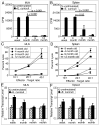Aging mice exhibit a functional defect in mucosal dendritic cell response against an intracellular pathogen
- PMID: 19017989
- PMCID: PMC2676144
- DOI: 10.4049/jimmunol.181.11.7977
Aging mice exhibit a functional defect in mucosal dendritic cell response against an intracellular pathogen
Abstract
Down-regulation of the immune response in aging individuals puts this population at a potential risk against infectious agents. In-depth studies conducted in humans and mouse models have demonstrated that with increasing age, the T cell immune response against pathogens is compromised and response to vaccinations is subdued. In the present study, using a mouse model, we demonstrate that older animals exhibit greater susceptibility to Encephalitozoon cuniculi infection, and their ability to evoke an Ag-specific T cell response at the gut mucosal site is reduced. The dampening of T cell immunity was due to the defective priming by the dendritic cells (DC) isolated from the mucosal tissues of aging animals. When primed with DC from younger mice, T cells from older animals were able to exhibit an optimal Ag-specific response. The functional defect in DC from older mice can be attributed to a large extent to reduced IL-15 message in these cells, which can be reversed by addition of exogenous IL-15 to the cultures. IL-15 treatment led to optimal expression of costimulatory molecules (CD80 and CD86) on the surface of older DC and restored their ability to prime a T cell response against the pathogen. To our knowledge, this is the first report which demonstrates the inability of the DC population from aging animals to prime a robust T cell response against an infectious agent. Moreover, the observation that IL-15 treatment can reverse this defect has far-reaching implications in developing strategies to increase vaccination protocols for aging populations.
Figures







 9 month old DC + E. cuniculi,
9 month old DC + E. cuniculi,  9 month old DC + E. cuniculi + IL-15). Results are presented as mean ± SD of triplicates and experiment was performed twice with similar results.
9 month old DC + E. cuniculi + IL-15). Results are presented as mean ± SD of triplicates and experiment was performed twice with similar results.Similar articles
-
IFN-gamma-producing dendritic cells are important for priming of gut intraepithelial lymphocyte response against intracellular parasitic infection.J Immunol. 2007 Aug 15;179(4):2485-92. doi: 10.4049/jimmunol.179.4.2485. J Immunol. 2007. PMID: 17675510 Free PMC article.
-
Plasmacytoid DC from aged mice down-regulate CD8 T cell responses by inhibiting cDC maturation after Encephalitozoon cuniculi infection.PLoS One. 2011;6(6):e20838. doi: 10.1371/journal.pone.0020838. Epub 2011 Jun 10. PLoS One. 2011. PMID: 21695169 Free PMC article.
-
Interleukin-12-producing CD103+ CD11b- CD8+ dendritic cells are responsible for eliciting gut intraepithelial lymphocyte response against Encephalitozoon cuniculi.Infect Immun. 2015 Dec;83(12):4719-30. doi: 10.1128/IAI.00820-15. Epub 2015 Sep 28. Infect Immun. 2015. PMID: 26416905 Free PMC article.
-
Immune response to Encephalitozoon cuniculi infection.Microbes Infect. 2001 Apr;3(5):401-5. doi: 10.1016/s1286-4579(01)01397-1. Microbes Infect. 2001. PMID: 11369277 Free PMC article. Review.
-
[Host immune response in mammals to Encephalitozoon cuniculi infection].Epidemiol Mikrobiol Imunol. 2004 Aug;53(3):136-41. Epidemiol Mikrobiol Imunol. 2004. PMID: 15524273 Review. Slovak.
Cited by
-
Porphyromonas gingivalis Provokes Exosome Secretion and Paracrine Immune Senescence in Bystander Dendritic Cells.Front Cell Infect Microbiol. 2021 Jun 1;11:669989. doi: 10.3389/fcimb.2021.669989. eCollection 2021. Front Cell Infect Microbiol. 2021. PMID: 34141629 Free PMC article.
-
A molecular mucosal adjuvant to enhance immunity against pneumococcal infection in the elderly.Immune Netw. 2015 Feb;15(1):9-15. doi: 10.4110/in.2015.15.1.9. Epub 2015 Feb 17. Immune Netw. 2015. PMID: 25713504 Free PMC article. Review.
-
The Confluence of Sex Hormones and Aging on Immunity.Front Immunol. 2018 Jun 4;9:1269. doi: 10.3389/fimmu.2018.01269. eCollection 2018. Front Immunol. 2018. PMID: 29915601 Free PMC article. Review.
-
Cross talk between histone deacetylase 4 and STAT6 in the transcriptional regulation of arginase 1 during mouse dendritic cell differentiation.Mol Cell Biol. 2015 Jan;35(1):63-75. doi: 10.1128/MCB.00805-14. Epub 2014 Oct 20. Mol Cell Biol. 2015. PMID: 25332236 Free PMC article.
-
Microsporidia: Obligate Intracellular Pathogens Within the Fungal Kingdom.Microbiol Spectr. 2017 Apr;5(2):10.1128/microbiolspec.funk-0018-2016. doi: 10.1128/microbiolspec.FUNK-0018-2016. Microbiol Spectr. 2017. PMID: 28944750 Free PMC article. Review.
References
-
- Zheng B, Han S, Takahashi Y, Kelsoe G. Immunosenescence and germinal center reaction. Immunol Rev. 1997;160:63–77. - PubMed
-
- Song H, Price PW, Cerny J. Age-related changes in antibody repertoire: contribution from T cells. Immunol Rev. 1997;160:55–62. - PubMed
-
- Garcia GG, Miller RA. Differential tyrosine phosphorylation of zeta chain dimers in mouse CD4 T lymphocytes: effect of age. Cell Immunol. 1997;175:51–57. - PubMed
-
- Homann D, Teyton L, Oldstone MB. Differential regulation of antiviral T-cell immunity results in stable CD8+ but declining CD4+ T-cell memory. Nat Med. 2001;7:913–919. - PubMed
Publication types
MeSH terms
Substances
Grants and funding
LinkOut - more resources
Full Text Sources
Medical

